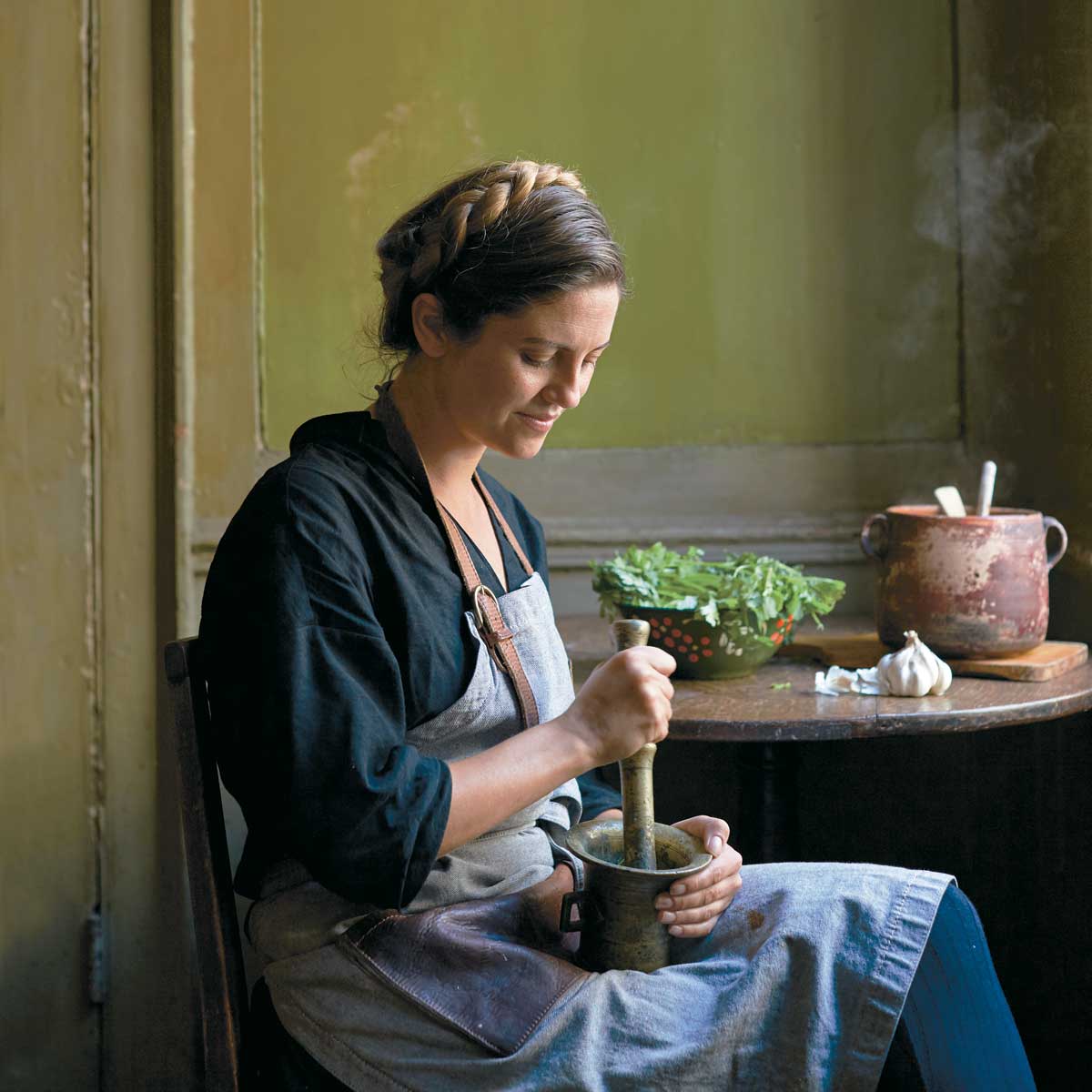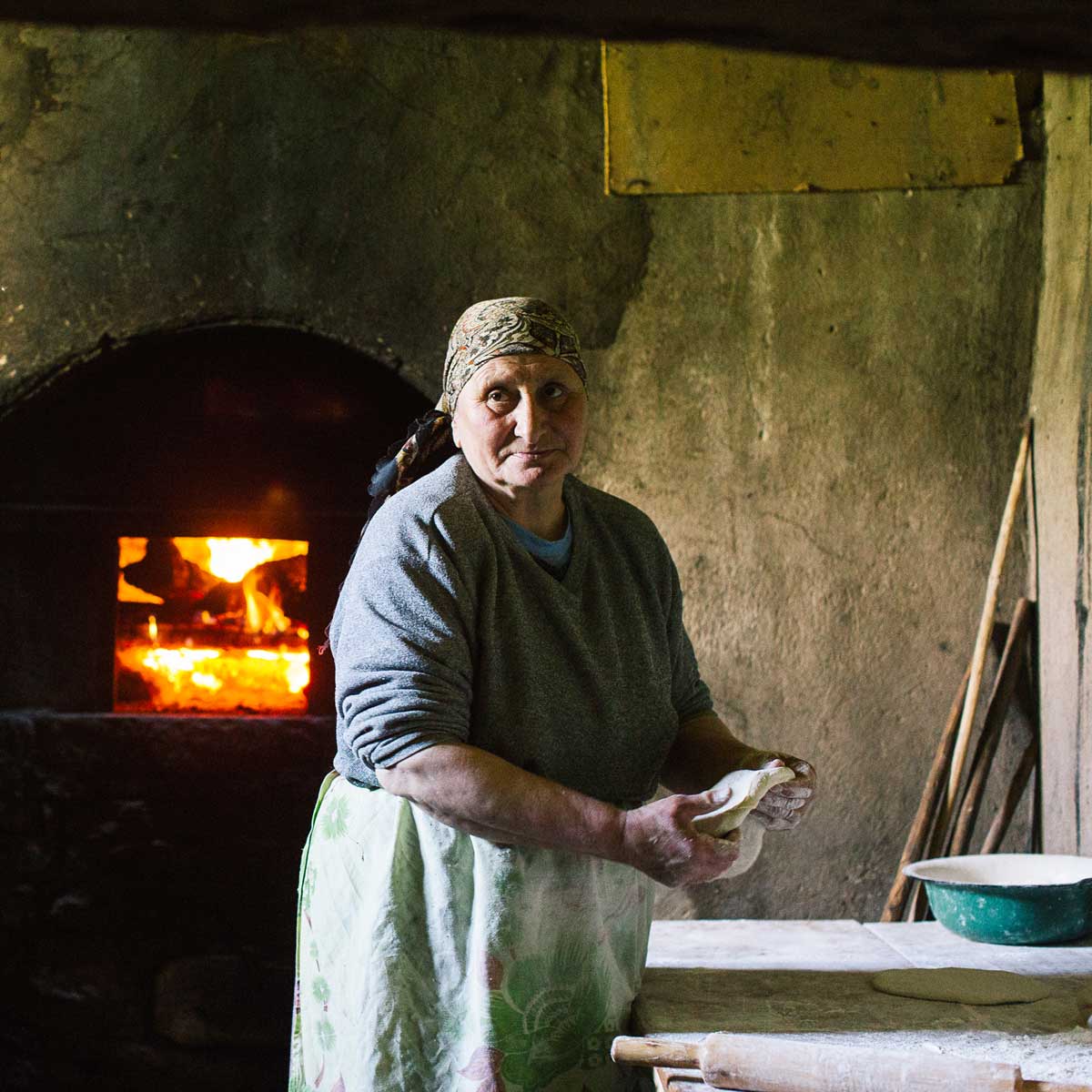Sustain / Real Bread Campaign / Articles
Microbakery in the mountains
Chef, food writer and author of the award-winning cookery book, Mamushka, Olia Hercules shares a childhood Real Bread story that helped inspire her to write the new book, Kaukasis.

The first time I have heard of the way bread was made in The Caucasus was from my aunt Nina. Her Armenian grandfather was originally from the Nagorno-Karabakh mountains; a region with a long, deep, and complicated history. When she was growing up in 1950s Soviet Azerbaijan, there was peace in the mountains; Armenian and Azeri villages tranquil among the craggy slopes, rows of crimson pomegranate orchards and fat-rumped sheep the only thing separating them.
Tending the tandyr
Nina told me about the way that bread was baked in their little Armenian village of Godrud. There was just one bakery - a clay house with a couple of tandyrs (the Caucasus version of the tandoor) and one woman - the baker. On the morning of a baking day every house in the village was busy. Every household would make their own dough and put it through the stages of rising and proving, but each family at different times. I have never heard of such a clever way of doing it; a proper community effort with consideration and respect.
The person who was nominated to start the dough first would shout across the village (it was not a very big village) “I am mixing the dough!” Then the family next door would wait for an hour or so before mixing their dough and then shout the same. So in a genius chain of bread mixing, kneading, proving and knocking back, every household would announce the stage that they were entering, coordinating everyone in such a way that there would be no queue or any other waste of time once it came to baking the bread.
“A genius chain of bread mixing, kneading, proving and knocking back”
The family that mixed the dough first would give it to the baker to stick into tandyr’s glowing belly, and the others will follow like clockwork - nobody waiting, stressing or arguing. I thought it was a wonderful story, a story that has inspired me to write Kaukasis.
Sadly I was unable to go to Godrud and in all honesty it still makes me cry, even now as I am writing this piece. Politicians and artificially-created conflicts have injected an intense amount of hatred between Armenians and Azerbaijanis, villages have been burnt down by either one nation or the other and I think it is safe to say that bread making doesn’t happen this way in the village anymore. I wanted to go to Godrud and check for myself, but they started shooting again there so I couldn’t risk it.
 Galina Elena by Elena Heatherwick www.elenaheatherwick.com
Galina Elena by Elena Heatherwick www.elenaheatherwick.com
Slow Food
What I did witness was outstanding bread baking in Akhaltzikhe, Georgia, which is not actually so far from the Armenian border. A woman called Galina, who is a rather famous farmer and cook, highly revered by the people from the Georgian branch of the Slow Food movement and everyone there who is trying to save the country’s forgotten, native foods - from wheat to grapes - nearly destroyed by Soviet endemic crops.
We came to her house and she took me down into a cellar, which turned out to be her home bakery. A large wooden stove, called a purne, was sleeping under a sturdy stone ceiling. Racks made of hazelnut branches rested on the bench by the stove, waiting for the hot breads to eventually rest upon its gnarly twigs and cool down. Galina’s seven year old grandson was running after her, helping her to mix the dough, which she left to rise in a wooden bath (I don’t have a better description for this dough trough) covered by an ornate, embroidered throw. A large goose feather lay nearby, its vanes sticky and glued together by egg yolks of the past. She must have used it to glaze breads for years - I know my Ukrainian grandmother did. Finally, the dough had risen and become puffed up with air bubbles, double its original size.
Galina lit the oven with pine branches, but just to start it off. “It’s is no good to cook bread in pine resin,” she said, “we only use it to start the fire.” Then, she used wood. I was so transfixed that I forgot to ask what it was, but I am more than sure something grown locally – perhaps more hazelnut twigs, or walnut and plum wood. The big fire will be going all day. Galina will tend to it from time to time, but really it has all been calculated or, rather, practised for so many years – centuries, even.
A beautiful scene
The initial strong heat of the purne would be used to bake lavashi, a thin flatbread almost like Iranian lavash, cooked in moments. After it was done, and the purne’s fire became just a little less fierce, Galina shaped and put in the second type of bread, the one with holes inside, called shoti. After that her incredible khachapouri, bread lathered with excellent pork lard (she had a 10kg bucket of it!) and filled with salty, local cheese. Finally, when the oven has cooled down, my guess would be - to about 180°C, she put in the somini, the largest bread of them all, which needed slow, even cooking. The breads were then cooled on the rough hazelnut rack. I have not seen a thing more beautiful than that scene in a long time.
This ingenious way of economising energy - utilising every bit of power and force that burning wood can provide - made me gasp. Another thing that impressed me and touched me deeply was Galina’s grandson; only little but so interested and interesting, learning the way to carry on this baking tradition, giving me hope we do not have to cry over its loss for a while yet.
First published in True Loaf magazine issue 33, October 2017
Published Tuesday 2 October 2018
Real Bread Campaign: The Real Bread Campaign finds and shares ways to make bread better for us, better for our communities and better for the planet. Whether your interest is local food, community-focussed small enterprises, honest labelling, therapeutic baking, or simply tasty toast, everyone is invited to become a Campaign supporter.

